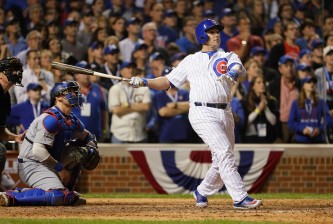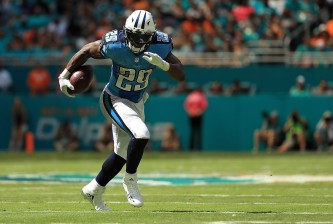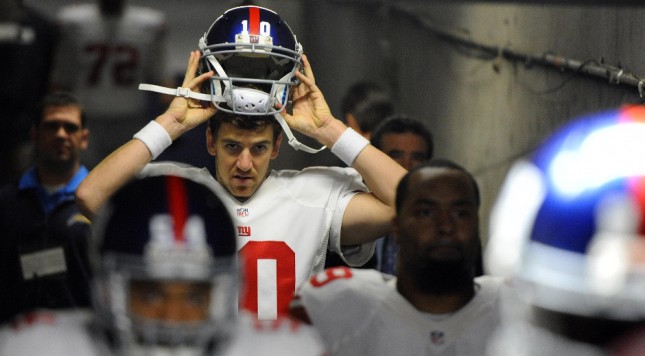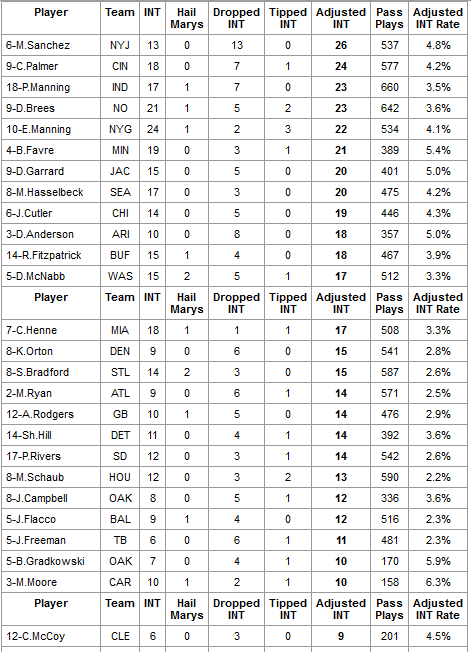Two Super Bowl wins. Two Super Bowl MVPs. An 8-3 postseason record in 10 NFL seasons with over 33,000 career passing yards. On paper, it sounds like the summation of a football player primed to enter Canton when he decides to hang it up in anywhere from four to Favre years.
Yet this is the resume of Giants quarterback Eli Manning, the enigmatic gunslinger more closely associated with “The Manning Face” and his penchant for throwing interceptions than winning among many NFL fans.
Perhaps some of it is anti-New York vitriol. Lord knows most sports fans dislike New York sports figures. Even those as classy as the younger Manning has been throughout his pro career.
Some of it is undoubtedly a sibling rivalry created by fans and the media alike. Eli will never be Peyton, and he really has no interest in trying to be. Where Peyton is a raging football maniac hellbent on perfection, Eli is as cool as a cucumber. He’s more than happy to make chicken salad out of chicken crap to win football games, and he’s done so quite often throughout his 10-year career.
But has this utter disdain and hysterical pleasure to bash Eli Manning caused us to overlook just how good the Big Blue quarterback truly is—at least most of the time? And yes, by us I include myself. I’ve written of Manning’s bloated “elite” status following the 2011 season and questioned just how good he ever truly was on more than one occasion.
For as consistent as Manning has been since entering the league as the San Diego Chargers first-overall pick in the 2004 NFL Draft and forcing a trade of his services to stay right in the New York area, his career has been an erratic display of ups and downs on the gridiron.
His first four NFL seasons were hard to watch. Inaccurate passing, too many interceptions and simply poor execution had Giants fans wondering if all the team had given up for the last of the great Manning bloodline was a mistake. Philip Rivers, the player the Giants traded to San Diego for Manning, was already better than Manning the minute he took over as the Chargers’ starter in 2006.
Meanwhile, linebacker Shawne Merriman and kicker Nate Kaeding (selected with draft picks the Giants gave to San Diego) were equally as impactful from day one. Merriman won the 2005 Defensive Rookie of the Year Award following a season during which he recorded 10 sacks. He followed that up with a 17-sack season in 2006 and 12.5 in 2007.
Something changed during the Giants’ playoff run following the 2007 season, however.
Having put together a flawed-but-much improved regular-season campaign, Manning helped guide the G-Men to the playoffs for the third consecutive season. And in that postseason run, he seemingly grew from boy to man, en route to the Giants’ first Lombardi Trophy in over a decade and a half.
Sure, there was stellar defensive play led by veteran pass rusher and captain Michael Strahan. A certain miracle put the Giants in position take the go-ahead and eventual game-winning score late in the fourth quarter.
But Manning flourished in the moment and finally took the stage when the Giants—and the NFL—needed him to most. It was assumed that the next step for Manning was quite obvious: joining the ranks of the league’s best quarterbacks.
Slowly, he seemed to be headed in that direction while still showing flashes of the sometimes-baffling decision maker. He would still force throws when he did not need to, if only for the sake of avoiding the sack.
His receivers have not always been conducive to the Giants’ success either. Too many times during his 25-interception campaign in 2010, giveaways charged to Manning were essentially handoffs from the receiver to opposing defensive backs.
An otherwise stellar 2010 season was marred by turnovers, as he notched a positive grade in seven games with just four negative performances on Pro Football Focus.
He finally reached the pinnacle the next year. But he did not do so without heightening the drama in perfect Eli Manning fashion.
In an interview on “The Michael Kay Show” on ESPN1050 AM, he was asked if he would put himself in the same class as NFL great Tom Brady. He said:
“I consider myself in that class. Tom Brady is a great quarterback, he’s a great player and what you’ve seen with him is he’s gotten better every year. He started off winning championships and I think he’s a better quarterback now than what he was, in all honesty, when he was winning those championships.
“I think now he’s grown up and gotten better every year and that’s what I’m trying to do. I kind of hope these next seven years of my quarterback days are my best.”
The quarterback responded to scoffs and criticism with the greatest season of his NFL career. He threw for a career-high 4,933 yards with 29 touchdowns and just 16 interceptions. However, his most amazing heroics came during the fourth quarter of games, when he threw a record-tying 15 touchdowns and guided the Giants to seven comebacks (the G-Men only won nine games).
Manning believed he was an elite quarterback and he assured that notion with an unforgettable campaign that did not end with spectacular regular-season production. Just like in 2007, Manning guided Big Blue through a challenging schedule of postseason opponents to meet with the New England Patriots and the very man he compared himself to in that radio interview and had already beaten in Super Bowl XLII, Tom Brady.
This time around, Manning shined bright while his counterpart, Brady, struggled under pressure. And when the Giants’ backs were against the wall, Manning delivered a 38-yard strike to Mario Manningham along the sideline—one of the greatest throws you will ever see.
Sports Illustrated’s Peter King captured the moment perfectly:
I still can’t get over that throw from Eli Manning to Mario Manningham. As much as I respect the catch (it will be the greatest of Manningham’s career, no matter how long he plays), I am in awe of the throw. How did Manning make that throw? Why make that throw? Why did he pick the target of the guy with a corner in coverage and a safety flying over to crush Manningham? The 38-yard throw—which began an 88-yard, Super Bowl-winning touchdown drive that Bill Belichick will see in his nightmares—is just one more reason to never, ever question how good Eli Manning is. He will have some crappy games the rest of his career, because two or three times a year he stinks. But I ask you: What quarterback alive do you want with the ball in his hands in the last two minutes of a big game?
Thought so. Eli Manning.
So often when he needs to be, Manning is the perfect quarterback. He makes all the right reads and puts the football exactly where it needs to be like so many other passers in the league can only dream of.
But on occasion, the bad Manning—the one who makes left-handed throws in the red zone and short-arms deep balls down the seam into the clutches of an opposing defensive backs—shows up to play and it can be unbearably frustrating to watch. Giants fans would be lying if they didn’t admit they have contemplated setting their No. 10 jerseys on fire at least once over the course of his 10-year NFL career.
They are also intelligent enough to keep calm when it comes to their offensive captain, because they known more often than not, he will come right back out on the next drive and connect with a Victor Cruz on a slant-and-go touchdown for 80 yards. Manning has always made some boneheaded decisions, but at the end of the day, he is one of the most dependable quarterbacks with the game on the line.
Predicting which persona the Jekyll-and-Hyde quarterback will take on in 2014 is difficult, but a new offensive scheme and a bevy of talented weapons put him in good position to succeed. Improved pass protection would certainly make his life easier.
He faced pressure 37.6 percent of the time in non-blitz situations, according to Pro Football Focus. This merely illuminates the offensive line issues everyone knew they had last season. However, it was a key problem for Manning and the Giants, and it forced him into a bad habit of making quick, ill-advised passes that often resulted in an interception.
Most pressure faced in 2.1-2.5 seconds: Matt Ryan, Eli Manning, Andrew Luck, Carson Palmer, Phillip Rivers, Tom Brady, Joe Flacco
— Pro Football Focus (@PFF) April 11, 2014
New offensive coordinator Ben McAdoo will seek to minimize those high-pressure situations, providing Manning with a scheme tailor-fitted to the team’s strengths which enables him to get the football out to a receiver quickly and move the chains. He will not have to sit in the pocket, wait for something to develop and the pocket to collapse all around him like he did when Kevin Gilbride was running the offense and pass protection was on a rapid decline over the last two seasons.
Ultimately, the great quarterback that Manning is should show through again—unless, of course, he is now on the decline himself. Many feel strongly about the argument that winning does not make one a great quarterback, however the two do generally go hand in hand. Manning has been a part of two Super Bowl winning teams and boasts a well above-average .563 winning percentage during the regular season in 10 years of play.
Legendary Hall of Fame 49ers coach Bill Wash once wrote when describing what he looked for in a quarterback through the NFL Draft:
The single trait that separates great quarterbacks from good quarterbacks is the ability to make the great, spontaneous decision, especially at a crucial time. The clock is running down and your team is five points behind. The play that was called has broken down and 22 players are moving in almost unpredictable directions all over the field.
This is where the great quarterback uses his experience, vision, mobility and what we will call spontaneous genius. He makes something good happen. This, of course, is what we saw in Joe Montana when he pulled out those dramatic victories for Notre Dame.
There have been few players in the NFL over the last decade who have excelled as well as Manning has in the situations Walsh speaks of. Sometimes numbers can be a misleading factor in a precise and strategic game such as football.
That could not be more true when it comes to Manning and his occasionally bloated interception totals. Though he may not be the “elite” quarterback he once proved himself to be, his already inaccurate arm may have dwindled a bit more and his arm strength may not be what it used to be, at the age of 33 he is still a lethal weapon with the football in his possession. As he has been throughout his entire career, he is an unpredictable asset whose greatest consistencies arise when an opponent least desires them to: in the fourth quarter, trailing by less than a touchdown with the defense on their heels.
More importantly, he has always been a winner. How he’s done so, at times, has left people in awe. But for a Giants franchise hoping to return to the playoffs for only the third time since winning their first Super Bowl with Manning behind center seven seasons ago, they will gladly put all their eggs in No. 10’s basket.
























